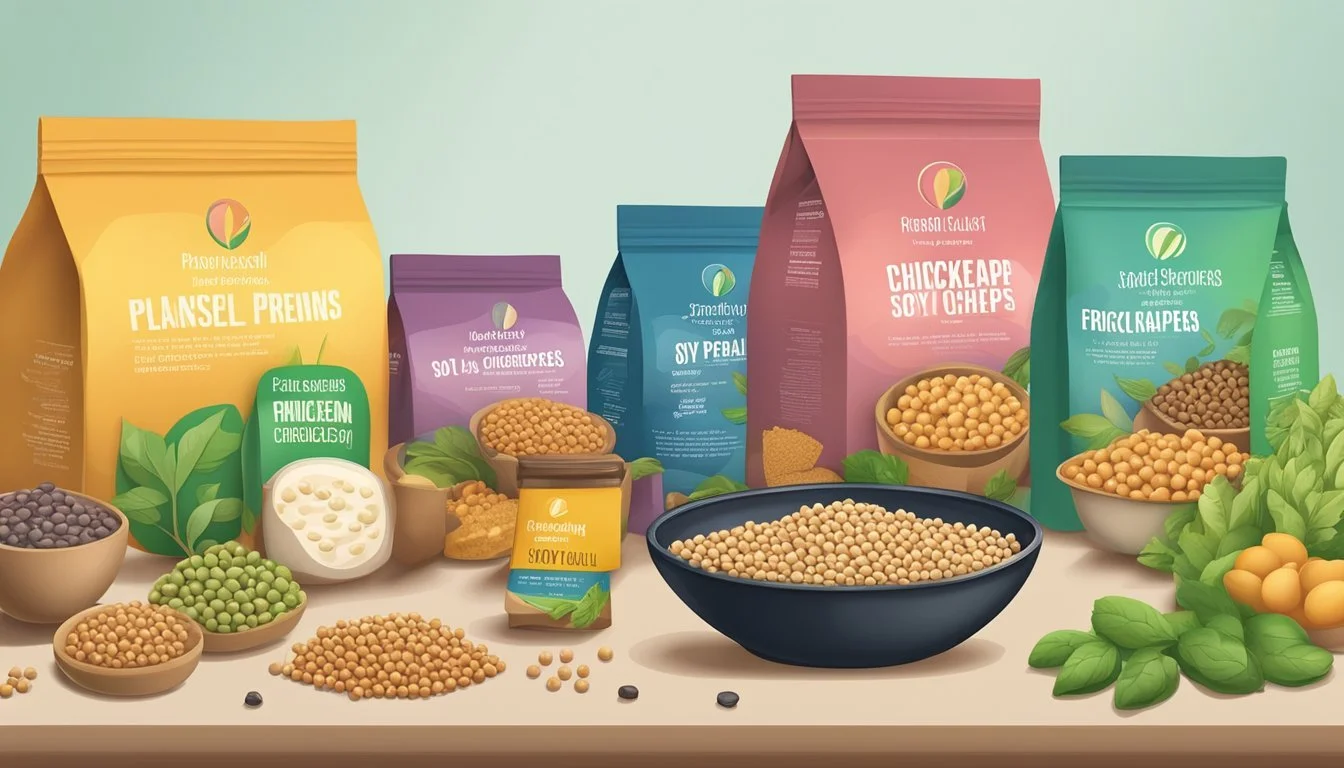Exploring Beyond Meat
Evaluating Pea Protein Alternatives for Carnivores
For many, the idea of substituting a juicy steak with a plant-based alternative might seem far-fetched, but the rise of options like Beyond Meat has been changing minds. Particularly notable among these alternatives is pea protein, heralded for its rich nutritional profile and minimal environmental impact. Pea protein provides a sustainable and efficient alternative that can cater to the protein needs of even the most committed carnivores.
With Beyond Meat's innovation, creating products that not only mimic the taste and texture of meat but also deliver on health benefits has drawn significant attention. Pea protein stands out because it offers all essential amino acids, making it a complete protein source. Furthermore, it is known to be easily digestible and allergy-friendly, offering an inclusive solution for those with dietary restrictions.
Beyond just health benefits, the environmental impact of choosing pea protein over traditional meat is substantial. Studies have shown that producing pea protein requires significantly fewer resources, reducing water usage and greenhouse gas emissions. This makes pea protein not just a personal health choice, but a step towards global sustainability.
Understanding Pea Protein
Pea protein offers a robust nutritional profile, often compared to animal proteins in terms of quality. The process of extracting pea protein involves multiple steps that enhance its functionality in food products.
Nutritional Profile
Pea protein is rich in essential nutrients. It contains approximately 20-25 grams of protein per 100 grams, making it a significant source for plant-based diets. Additionally, it includes a good amount of dietary fiber, which aids in digestion.
While low in fat, pea protein is also a source of various vitamins and minerals, including iron, which supports blood health, and magnesium, which plays a critical role in various biochemical reactions. The absence of cholesterol makes it a heart-friendly alternative.
Protein Quality Comparisons
Comparing pea protein to other protein sources, such as whey or soy, it is seen that pea protein provides a well-balanced amino acid profile. It includes essential amino acids like lysine, which supports tissue repair and muscle growth.
Pea protein's digestibility is slightly lower than that of animal proteins, but it is still considered adequate for most dietary needs. This makes it a versatile option for those seeking to avoid allergens present in dairy or soy.
Pea Protein Processing
The process of creating pea protein isolate involves several steps. Initially, whole peas are cleaned and milled to remove the outer shell. The resulting flour undergoes a wet filtration process, separating the protein from starch and fiber.
This protein concentrate is then dried and ground into a fine powder, often achieving a protein content of around 85-90%. The resulting pea protein isolate has a fibrous texture, which can be used in a variety of food applications, including meat alternatives and protein shakes. The process is designed to retain most of the nutritional qualities of the peas.
Health Implications
Examining the health impacts of pea protein-based alternatives like Beyond Meat, several critical areas emerge where these plant-based options could influence one's well-being.
Heart Health
Pea protein alternatives generally contain lower levels of saturated fats and trans fats compared to traditional animal meats. For example, a Beyond burger has around 6.1 grams of these fats, whereas equivalent beef patties can have 9.9 grams. Reducing intake of these fats can help lower cholesterol levels, which is beneficial for heart health.
Studies also suggest that switching to plant-based meat could reduce the risk of heart disease due to its unique composition of fats. Additionally, these alternatives are often fortified with vitamin C, which plays a role in maintaining healthy blood vessels and possibly reducing heart disease risk.
Weight Management
Pea protein meat alternatives can support weight management efforts through several mechanisms. They are typically lower in calories compared to their meat counterparts. This calorie difference can contribute to weight loss when these products replace higher-calorie meats in the diet.
The high fiber content in many plant-based meats can promote a feeling of fullness, reducing overall calorie intake. Fiber also aids in stabilizing blood sugar levels, another critical factor in managing weight. These aspects make pea protein products an appealing option for those looking to control their weight.
Muscle Maintenance
Pea protein is rich in essential amino acids, necessary for muscle maintenance and repair. This makes plant-based meats a viable option for those looking to maintain or build muscle. The high-quality protein content in products like Beyond Meat can mirror the muscle-building benefits provided by traditional animal-based proteins.
Research indicates that consistent consumption of adequate amounts of protein, whether from plant or animal sources, supports overall muscle health. Plant-based meats are formulated to include concentrated protein sources that ensure individuals can meet their nutritional needs.
Digestive Health
The fiber content in pea protein meat alternatives is often higher than that found in animal meats. This fiber supports digestive health by promoting regular bowel movements and preventing constipation. Fiber also serves as a prebiotic, fostering a healthy gut microbiome, which is important for overall digestive health.
Moreover, these plant-based products usually lack certain compounds found in meat that can be hard on digestion, such as saturated fats and certain proteins. This makes them a more digestible option for many people, contributing to better digestive comfort and function.
Carnivore Diet Analysis
The Carnivore Diet advocates for an all-meat dietary regimen, focusing solely on animal-based foods such as red meat, organ meat, and eggs. This section addresses the key nutritional concerns and potential benefits associated with this diet.
Nutritional Concerns
The Carnivore Diet eliminates all plant-based foods, raising several nutritional concerns. One major issue is the risk of vitamin C deficiency, which can lead to scurvy. Although meat contains minimal amounts of vitamin C, it is often insufficient to meet daily requirements. Additionally, the absence of fruits and vegetables may result in a lack of dietary fiber, potentially causing digestive issues.
Certain minerals and vitamins typically found in plant-based foods, such as folate and certain B vitamins, may also be inadequate. There is limited long-term research on the diet's effects, so it remains uncertain how well it can support complete nutritional needs over time. Critics argue that strict adherence could lead to nutrient imbalances.
If you're looking for vitamin C, buying it online is your best bet!
Benefits of Meat Consumption
Proponents of the Carnivore Diet argue that meat provides several health benefits. Red meat and organ meats are rich in essential nutrients, including high-quality proteins, iron, and zinc. These nutrients are crucial for muscle maintenance, energy levels, and overall bodily functions.
A high-protein, high-fat diet can enhance satiety, potentially aiding in weight loss. Supporters claim that it can also lead to improved mental clarity and energy. Some high-profile advocates like Joe Rogan and Shawn Baker have shared personal anecdotes of increased vitality and reduced inflammation. However, individual responses can vary significantly.
In summary, while the Carnivore Diet poses certain nutritional concerns, proponents highlight the benefits of consuming nutrient-dense animal products.
Environmental and Ethical Considerations
Environmental and ethical aspects of meat production and plant-based alternatives are critical. This encompasses sustainability, greenhouse gas emissions, and animal welfare.
Sustainability of Meat Production
Traditional meat production, especially beef, is notorious for its significant environmental footprint. Beef production generates substantial greenhouse gas emissions and requires large amounts of water and land. According to sources, producing a single pound of beef can require up to 1,800 gallons of water. Furthermore, livestock farming contributes to deforestation and habitat destruction.
Organic and sustainable farming methods attempt to mitigate these effects, but challenges remain. By reducing meat consumption and exploring alternatives, like plant-based burgers, there is potential to alleviate some of the environmental strain.
Beyond Meat's Environmental Impact
Beyond Meat's plant-based burger offers a more sustainable option compared to traditional beef. The 2022 ESG Report highlights significant reductions in greenhouse gas emissions and resource use with the Beyond Burger® 3.0. Their environmental life cycle assessment (LCA) demonstrates that their burgers reduce emissions considerably.
Additionally, Beyond Meat's products use fewer resources such as water and land. The plant-based burger is less demanding on the environment and offers an ethical alternative by decreasing reliance on animal meat, which aligns with the broader goal of reducing environmental impact.
Comparative Taste and Culinary Usage
An examination of pea protein in Beyond Meat products reveals notable insights about their texture, flavor, and versatility in cooking. This analysis explores the specifics of these aspects and how they compare to traditional meat.
Texture and Flavor
Pea protein in plant-based burgers often aims to replicate the mouthfeel of beef. The texture can be slightly different, frequently softer and less fibrous than typical meat. Some hybrid meat products blend plant-based ingredients with meat, attempting to strike a balance between taste and texture.
Flavor-wise, Beyond Meat burgers are formulated to mimic the savory, umami notes of beef. Spices and flavorings play a critical role in achieving similarities. Consumers show a mild preference for plant-based alternatives that taste like meat.
Cooking with Pea Protein
Cooking with pea protein requires some adjustments. For instance, Beyond Meat burgers can be grilled, pan-fried, or barbequed similarly to beef burgers. However, they might require less cooking time to avoid drying out, and the moisture content can affect how they handle in culinary applications.
Plant-based burgers offer flexibility in recipes. They can be used in a variety of dishes, from classic burger setups to more innovative culinary creations. Since they have a neutral flavor base, they can adapt to a range of spices and sauces, allowing versatility in meal planning.
Alternatives to Pea Protein
Pea protein isn't the only option for those seeking alternatives. Various plant-based and animal-based protein sources offer unique benefits.
Other Plant-Based Options
Several alternative plant-based proteins include soy, seeds, nuts, and legumes. Soy protein is a prominent choice due to its complete amino acid profile, mirroring what is found in animal proteins.
Nuts and seeds (such as chia and flax seeds) provide an excellent source of protein, healthy fats, and fiber. Nut butters, including almond and peanut butter, offer convenient and tasty ways to incorporate plant protein.
Legumes, such as lentils and chickpeas, are also high in protein and can be used in various dishes from salads to stews. These options enable diversity in diet and can cater to various nutritional needs.
Animal-Based Supplements
For those considering animal-based options, bone broth, fish eggs, and dairy are notable sources. Bone broth, rich in collagen, supports joint health and provides a high-protein broth.
Fish eggs, often called roe, are packed with essential omega-3 fatty acids along with protein. Dairy products like Greek yogurt, cottage cheese, and milk supply high-quality protein and are accessible.
Additionally, one can find protein supplements derived from these sources. These include whey protein from dairy and collagen peptides from animal connective tissues. Each of these provides a bioavailable and varied amino acid profile, beneficial for muscle maintenance and overall health.
Beyond Meat in a Balanced Diet
Incorporating Beyond Meat into a balanced diet requires thoughtful meal planning that takes into account the benefits and considerations of plant-based alternatives. This section explores how to integrate Beyond Meat products while maintaining dietary variety and flexibility.
Incorporating Plant-Based Alternatives
Incorporating Beyond Meat into a balanced meal plan can provide a source of protein that complements other food groups. Beyond Meat products, such as burgers and sausages, offer 12 grams of protein per serving. They also have less saturated fat and no cholesterol compared to conventional meat.
To maintain a balanced diet, it's essential to combine Beyond Meat with vegetables, fruits, whole grains, and legumes. For example, a Beyond Meat burger can be paired with a mixed green salad and whole grain bun, creating a nutrient-dense meal. By integrating these meat alternatives into a diet, individuals can benefit from the nutritional profile of plant-based proteins while reducing their intake of animal-derived saturated fats and cholesterol.
Diet Variety and Flexibility
A good diet focuses on variety and flexibility, allowing room for different food groups while meeting nutritional needs. Beyond Meat fits well into a flexitarian diet, where people predominantly eat plant-based but include meat occasionally. This approach helps individuals enjoy the benefits of plant-based foods without completely eliminating animal products.
Variety in the diet is crucial. It prevents nutrient deficiencies and keeps meals interesting. Beyond Meat can be part of a diverse meal plan that includes a range of fruits, vegetables, grains, nuts, and seeds. Incorporating different food groups ensures a broad spectrum of nutrients, promoting overall health and well-being.
Meal planners can look at Beyond Meat as an option to diversify protein sources. For dinner, one might have a Beyond Meat sausage with roasted vegetables and quinoa. This not only adds to the variety of meals but also supports a balanced and nutritious diet.
Market Trends and Consumer Behavior
Consumer behavior and market trends are shifting significantly towards plant-based alternatives. Cultural and social influences play crucial roles in this change, as many consumers adopt vegan or flexitarian diets for health, environmental, and ethical reasons.
Shift Towards Plant-Based Eating
The adoption of plant-based meat alternatives is increasing. The market for these products has seen substantial growth, driven by health-conscious consumers and those with dietary restrictions.
Plant-based meat alternatives, such as those made from pea protein, are becoming more common in grocery stores and restaurants. In 2024, the plant-based food market saw a 29% increase, highlighting the growing consumer demand.
Consumers are choosing plant-based options for various reasons. Health benefits, such as lower cholesterol and reduced risk of heart disease, are significant factors. Additionally, environmental concerns about the sustainability of traditional meat production drive many to seek alternative proteins.
Cultural and Social Influences
Cultural shifts towards plant-based diets are evident in many parts of the world. In countries like Germany, France, and Italy, meat consumption has steadily decreased, while the popularity of plant-based foods rises.
Social media and celebrity endorsements play a notable role in influencing consumer behavior. Influencers and public figures advocating for plant-based diets have contributed to changing perceptions around vegan and flexitarian lifestyles.
Furthermore, there is an increase in awareness of the ethical implications of meat consumption. Documentaries and educational campaigns highlight issues related to animal welfare, encouraging consumers to consider plant-based alternatives.
Economic factors also influence consumer choices, as advancements in technology make plant-based products more accessible and affordable. As these trends continue, the market for alternative proteins, including pea protein, is poised for continued expansion.










